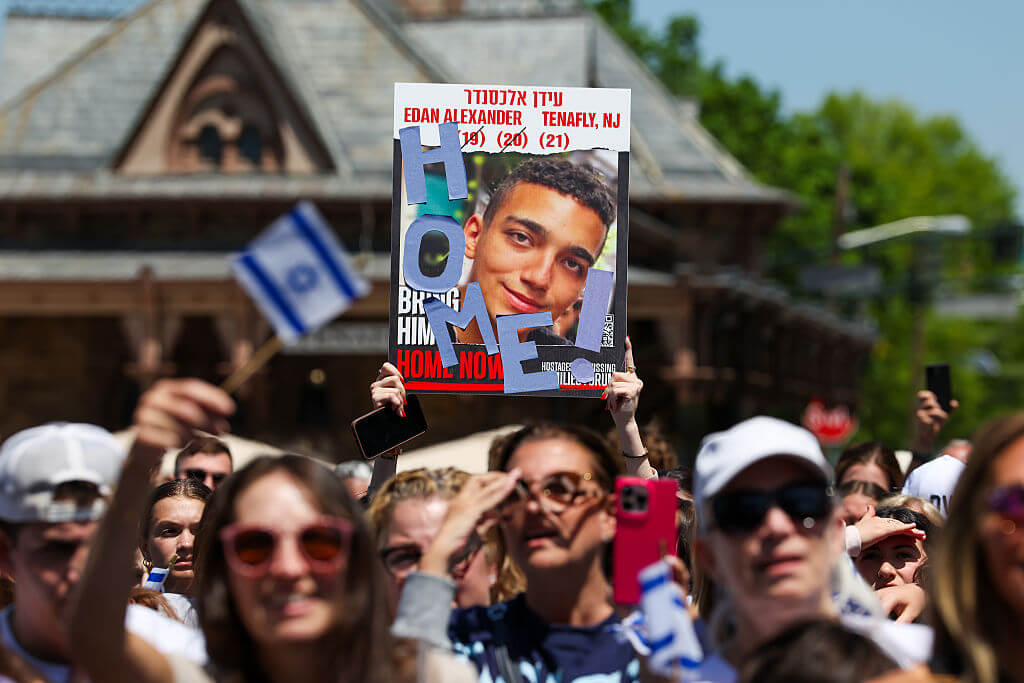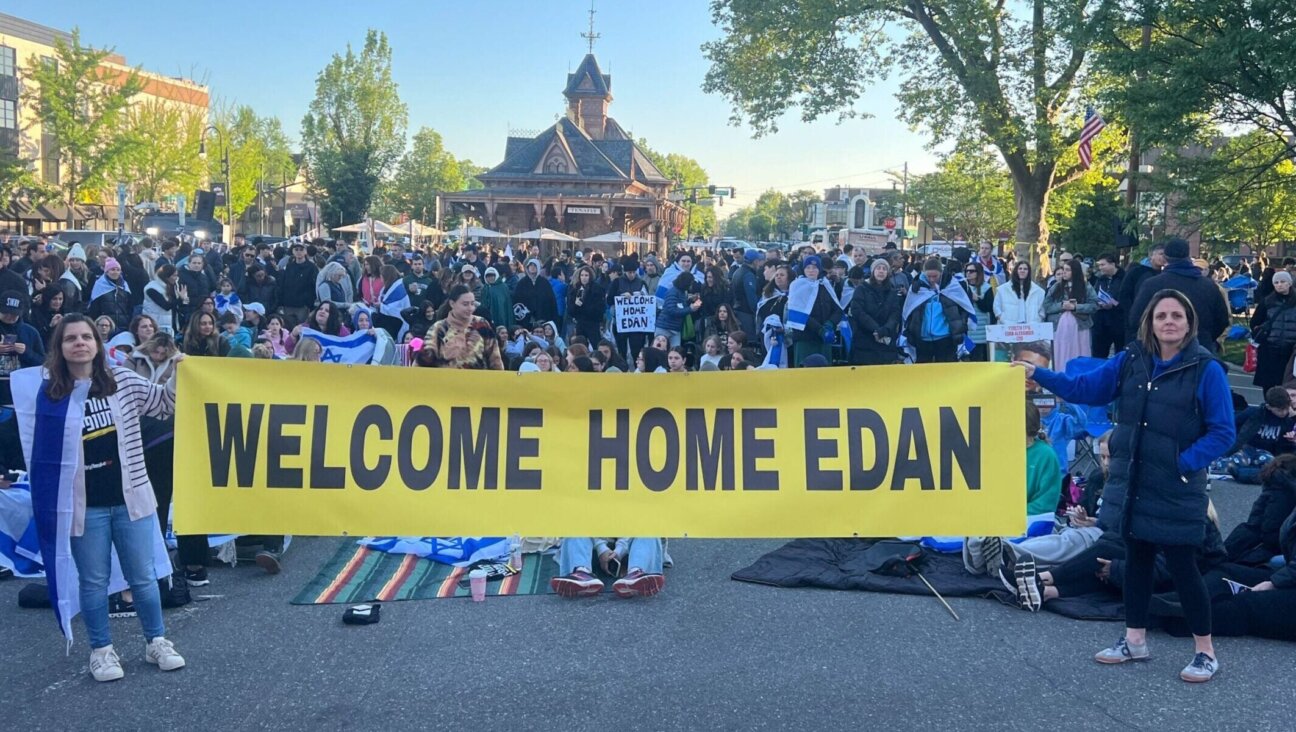South Florida’s Jewish Community Grows Beyond Its Retirees

An Orthodox Jewish woman takes in some sun in Miami. Image by Flickr
(JTA) — At the Urban Rustic Cafe in a strip mall in this city located between Miami to the south and the Palm Beach retirement communities to the north, the line for a table stretches out the door and into the parking lot.
Inside the kosher establishment, the volume is loud. An elderly Orthodox man sitting near the window leans across a table to hear what his wife is saying. At the dessert counter, a gaggle of boys with tzitzis fringes hanging from their shirts have their noses pressed against the glass.
Nearby, two stylishly dressed 30-something women chatter away in Spanish, one of them rocking a young baby. As the blond waitress trying to serve them bumps hips with a busboy, the two have a brief exchange in rapid-fire Hebrew.
Welcome to South Florida’s Jewish community, an amalgam of retirees, Latin American immigrants, Orthodox families, Holocaust survivors and plenty more.
More than half a million Jews live in three counties there – Miami-Dade, Broward and Palm Beach – making the region America’s third-largest Jewish metro area behind only New York and Los Angeles. Add in the smaller Jewish communities elsewhere in Florida, and one of every 10 American Jews resides in the Sunshine State.
While many are retirees, Florida isn’t just a place for elderly Jews. A combination of factors – lower costs of living than in the Northeast, the lack of state income tax, Jewish institutional infrastructure, the draw of Miami to Latin American immigrants and, yes, the weather – has helped turn Florida into one of America’s largest, most diverse and most unusual Jewish communities.
“I think today we are no longer simply a retirement community,” said Jewish demographer Ira Sheskin, a professor of geography at the University of Miami.
The Jews of South Florida boast several distinctions. Palm Beach County has the oldest median Jewish age in the country, 70, according to the last Jewish community study of the area. The southern part of Palm Beach County has the highest density in the country of Jews proportionate to the total population: 49 percent, according to the same survey.
In the Miami area, a massive influx of Latin American immigrants since 2000, particularly from Venezuela, Argentina and Mexico, has reduced the Jewish community’s average age and brought far more Latin American diversity to a population whose Spanish speakers once were overwhelmingly Cuban exiles. The last Jewish population study conducted in Miami-Dade, in 2004, found that the county had the largest percentage of foreign-born Jews of any Jewish community in America.
“We’re such an international community,” said Jacob Solomon, CEO of the Greater Miami Jewish Federation. “Clearly, the big story is the continuing Latin immigration and what that means.”
Nobody knows for certain how many Jews live in South Florida, because the most recent community studies are about a decade old. At last count, local federations’ studies found 256,000 Jews in Palm Beach County (2005); 186,500 Jews in Broward County (2008); and 113,000 Jews in Miami-Dade (2004). Miami began work on a new survey last month, but the results are not expected until fall.
Even without solid numbers, however, there are some clear signs of the changes underway in South Florida Jewry, especially growth beyond retirees.
As in many other regions across the country, there has been a significant expansion over the last decade or two in Orthodox synagogues, kosher restaurants and Jewish day schools, suggesting that the area’s Orthodox population is growing, particularly in Hollywood, Miami Beach, Aventura and Boca Raton.
“Boca has the largest density in the Miami area of Jewish people per square mile,” said Deborah Shapiro, manager of loyalty marketing at the big-box grocery retailer Winn-Dixie, which conducted extensive demographic research in the area before investing $3 million to revamp its Boca Raton supermarket last year to focus on kosher consumers.
Since completing the remodeling – the store’s kosher offerings now include a pizza shop, fresh sushi counter, bakery, and meat and deli counter – business in the store’s kosher departments has tripled, according to Shapiro. Winn-Dixie has two other stores in South Florida with in-store kosher operations and full-time kosher supervisors, in Aventura and Tamarac.
In Miami Beach, the story has been the growing number of young families, prompting the recent construction of a new building for a JCC that for years had been housed in a 1920s-era mansion. Completed in October 2012, the 37,000-square-foot Miami Beach JCC already has 1,700 member units – about 5,000 people.
“The influx of young families and the role that the center can play for them gave momentum to the project,” Jay Roth, the JCC’s executive director, told JTA. “This is a community that is committed to culture and growth.”
A few miles to the north, the community around the Michael-Ann Russell JCC in North Miami Beach, near Aventura, also is growing, thanks to Latin American Jewish families.
Located between an Orthodox-run, 1,000-student day school on one side and a 440-student Reform Jewish day school and synagogue on the other, the JCC’s single-largest constituency is Latin American Jewish immigrants who have moved to the area since 2000 fleeing economic or political insecurity at home. At both day schools, too, the students are overwhelmingly Latin American.
“In the last 15 years, especially since 2001, there’s been a gradual increase in the number of Spanish-speaking kids,” said Nancy Posner, head of the Reform day school, Jacobson Sinai Academy. “Now we have students from 17 different countries. It’s a microcosm of Miami.”
While Miami-Dade has the fewest Jews of the three counties, its population is the most stable because it has more young people and fewer retirees.
“It gives us a more normalized age period and more stable base,” said Solomon of the Miami federation. “The northern South Florida communities still have to go through that demographic adjustment.”
Farther north, in Broward County, losses due to mortality have prompted a steep decline in the Jewish population – by about 55,000 between 1997 and 2008. Far fewer new retirees are moving in.
“Over the course of the past 20 years or so, there clearly has been a drop-off as retirees have passed away or moved back North to move in with their adult children,” said Eric Stillman, CEO of the Jewish Federation of Broward County.
The story is different in Palm Beach County, which remains the No. 1 destination in America for Jewish retirees. The county’s Jewish population exploded in the 1990s and early 2000s. While growth probably has leveled off, according to Sheskin’s demographic estimates, the expected retirement of the baby boomers likely will help Palm Beach keep up its Jewish numbers in the coming years.
“I think we’re losing an older generation, but we’re getting new people to retire here all the time,” said Matthew Levin, CEO of the Jewish Federation of South Palm Beach County.
The story of Florida Jewry has not been one of unchecked growth. The Jewish community of Miami is still far below its peak, when it numbered nearly 250,000 in the late 1970s, and Broward is down from its high of nearly 300,000 in 1990.
What’s different about South Florida today is that the region increasingly is a place where second- and third-generation Jews are being born, growing up and choosing to raise families of their own.
“Increasingly, Florida is a place where people come and stay,” said the Roth of the Miami Beach JCC.
The Forward is free to read, but it isn’t free to produce

I hope you appreciated this article. Before you go, I’d like to ask you to please support the Forward.
Now more than ever, American Jews need independent news they can trust, with reporting driven by truth, not ideology. We serve you, not any ideological agenda.
At a time when other newsrooms are closing or cutting back, the Forward has removed its paywall and invested additional resources to report on the ground from Israel and around the U.S. on the impact of the war, rising antisemitism and polarized discourse.
This is a great time to support independent Jewish journalism you rely on. Make a gift today!
— Rachel Fishman Feddersen, Publisher and CEO
Support our mission to tell the Jewish story fully and fairly.
Most Popular
- 1

Fast Forward Ye debuts ‘Heil Hitler’ music video that includes a sample of a Hitler speech
- 2

Opinion It looks like Israel totally underestimated Trump
- 3

Culture Is Pope Leo Jewish? Ask his distant cousins — like me
- 4

Fast Forward Student suspended for ‘F— the Jews’ video defends himself on antisemitic podcast
In Case You Missed It
-

News In Edan Alexander’s hometown in New Jersey, months of fear and anguish give way to joy and relief
-

Fast Forward What’s next for suspended student who posted ‘F— the Jews’ video? An alt-right media tour
-

Opinion Despite Netanyahu, Edan Alexander is finally free
-

Opinion A judge just released another pro-Palestinian activist. Here’s why that’s good for the Jews
-
Shop the Forward Store
100% of profits support our journalism
Republish This Story
Please read before republishing
We’re happy to make this story available to republish for free, unless it originated with JTA, Haaretz or another publication (as indicated on the article) and as long as you follow our guidelines.
You must comply with the following:
- Credit the Forward
- Retain our pixel
- Preserve our canonical link in Google search
- Add a noindex tag in Google search
See our full guidelines for more information, and this guide for detail about canonical URLs.
To republish, copy the HTML by clicking on the yellow button to the right; it includes our tracking pixel, all paragraph styles and hyperlinks, the author byline and credit to the Forward. It does not include images; to avoid copyright violations, you must add them manually, following our guidelines. Please email us at [email protected], subject line “republish,” with any questions or to let us know what stories you’re picking up.














